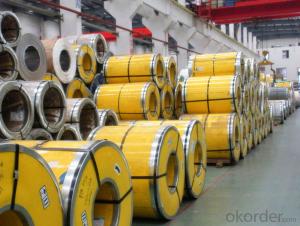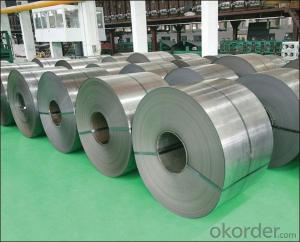Hot Rolled Cold Rolled Stainless Steel Coil and Sheet 201 /202 High Quality
- Loading Port:
- China main port
- Payment Terms:
- TT OR LC
- Min Order Qty:
- 200 m.t.
- Supply Capability:
- 4000 m.t./month
OKorder Service Pledge
OKorder Financial Service
You Might Also Like
201 Stainless Steel Coil Hot Rolled Cold Rolled
201 Stainless Steel is a new kind of Austenite stainless steel by used Mn, N replace Ni. The steel has good corrosion resistance and hot / cold processing performance, instead of 304 stainless steel products for used in the not high of corrosive environment, such as indoor, inland city outdoor etc.
1. Product detail
Product name: 201 Stainless Steel Coil
Thickness: 0.2mm to 1.5mm
Technical: Cold Rolled
Width: 10mm to 1240mm
Type: 200 Series
Length: As customer's requested
Standard: JIS, SUS
Finish: BA, 2B, 8K, NO.3, NO.4, HL
MOQ: 200 Metric Tons
2. Specialty and Applications
Steel Type | 201 Stainless Steel Coil |
Specialty | -- After solid solution treatment has high strength, toughness and wear resistance; Economical, low Ni components to ensure the cost advantage |
Applications | -- 201 Stainless Steel mainly used in decorated tube, Industrial tube and other shallow tensile productSuch as shallow processed pan, Indoor stair handrail, elevator etc |
3. Chemical Composition (Unit: WT %)
Specification | C | Si | Mn | Ni | Cr | other |
201 Stainless Steel | ≤0.015 | ≤1.00 | 7.0-10.0 | 3.5-5.5 | 14.0-16.0 | N ≤ 0.20 |
4. Mechanical Property
Specification | YS (Mpa) | TS (Mpa) | EL(%) | HV | REMAK |
201 Stainless Steel | 426 | 880 | 52 | 224 | 1.0t |
304 Stainless Steel | 285 | 710 | 58 | 165 | 1.0t |
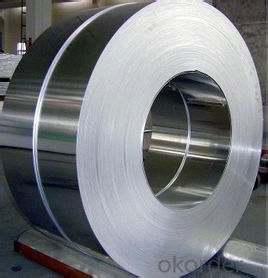
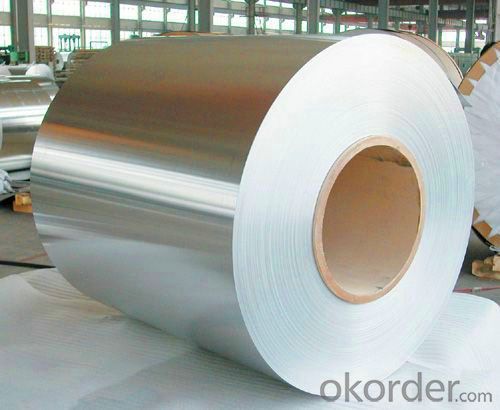
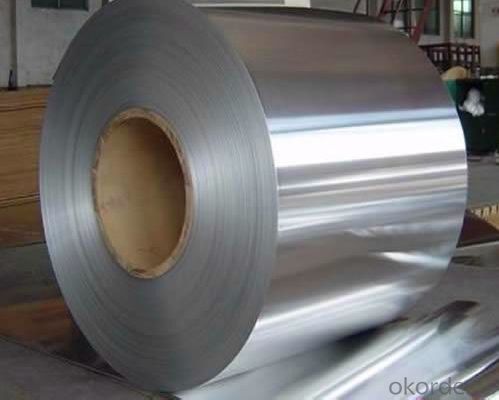
- Q:Are stainless steel strips resistant to sulfuric acid?
- Generally, stainless steel strips exhibit resistance to sulfuric acid. This material is renowned for its corrosion-resistant nature and can withstand various chemicals, such as sulfuric acid, due to its high resistance. Nevertheless, the level of resistance may differ depending on the grade and composition of the stainless steel. When exposed to highly concentrated and hot sulfuric acid solutions, certain types of stainless steel may encounter limited corrosion. To ensure the appropriateness of stainless steel strips for a particular sulfuric acid application, it is advisable to seek guidance from a materials specialist or consult specific corrosion resistance charts.
- Q:What is the difference between annealed and tempered stainless steel strips?
- Annealed and tempered stainless steel strips are two different heat treatment processes that result in different properties and characteristics of the material. Annealing is a process in which the stainless steel strip is heated to a specific temperature and then slowly cooled, usually in a controlled atmosphere. This process helps to relieve internal stresses and improve the ductility and machinability of the material. Annealed stainless steel strips have a lower hardness and are softer, making them easier to work with and form into various shapes. They also have improved resistance to corrosion and are less prone to cracking or breaking under stress. On the other hand, tempering is a process that involves heating the stainless steel strip to a specific temperature and then rapidly cooling it. This process is typically done after the steel has been hardened through quenching, which involves rapidly cooling the material to increase its hardness. Tempering helps to reduce the brittleness of the hardened steel and improve its toughness and ductility. Tempered stainless steel strips have a higher hardness and are more resistant to wear and deformation, making them suitable for applications that require higher strength and durability. In summary, annealed stainless steel strips are softer, more ductile, and have improved corrosion resistance, while tempered stainless steel strips are harder, more wear-resistant, and have higher strength and toughness. The choice between annealed and tempered stainless steel strips depends on the specific application and the desired properties of the material.
- Q:How do stainless steel strips resist embrittlement?
- Stainless steel strips resist embrittlement due to their unique composition, which includes a high percentage of chromium. Chromium forms a protective oxide layer on the surface of the steel, preventing corrosive elements from penetrating and causing embrittlement. Additionally, the presence of other alloying elements like nickel and molybdenum further enhances the resistance to embrittlement by improving the steel's ability to withstand high temperatures and corrosive environments.
- Q:What is the hardness of stainless steel band 3/4?
- Hello, 3/4H stainless steel has too many materials, I don't know what kind of material you are talking about 301 and 304 are different. 3013/4H harder. 304 soft. And 201430, etc.... All different
- Q:Can 111 stainless steel strips be coated with anti-galling coatings?
- Yes, 111 stainless steel strips can be coated with anti-galling coatings.
- Q:Are stainless steel strips suitable for high-temperature oxidation?
- Stainless steel strips are indeed appropriate for high-temperature oxidation. Renowned for their exceptional resistance to oxidation and corrosion, stainless steel is an optimal choice for scenarios involving elevated temperatures. The protective oxide layer formed by the chromium content in stainless steel effectively obstructs further oxidation at heightened temperatures. This oxide layer acts as a shield against the detrimental impact of oxygen and other elements, thus guaranteeing the long-lasting and robust nature of stainless steel strips even in environments with high temperatures. Furthermore, stainless steel alloys containing higher levels of chromium, nickel, and other alloying elements display even greater resistance to oxidation, making them particularly suitable for exceedingly high-temperature applications.
- Q:What are the different types of stainless steel strip edges?
- There are several different types of stainless steel strip edges that are commonly used in various applications. These include: 1. Mill Edge: This is the standard edge produced during the hot rolling process. It has a slightly rounded edge and may have some mill scale present. 2. Slit Edge: This edge is produced by slitting the coil into narrower strips. It is a straight edge with a smooth finish and no burrs. 3. Deburred Edge: This edge is created by removing any burrs or sharp edges from the slit edge. It provides a smoother and safer finish. 4. Rounded Edge: This edge is achieved by rounding the sharp edges of the strip. It is commonly used in applications where safety is a concern, such as in the food industry. 5. Beveled Edge: This edge is created by beveling the strip at a specific angle. It is often used in applications where a tight fit or welding is required. The choice of stainless steel strip edge depends on the specific application and the desired finish. Each edge type has its advantages and may be suitable for different purposes.
- Q:Are 111 stainless steel strips resistant to intergranular corrosion?
- Yes, 111 stainless steel strips are resistant to intergranular corrosion.
- Q:Are stainless steel strips suitable for cryogenic applications?
- Yes, stainless steel strips are suitable for cryogenic applications. Stainless steel has excellent mechanical properties and can withstand extremely low temperatures without losing its strength and durability. It also has good resistance to corrosion, making it a reliable choice for cryogenic environments.
- Q:How do stainless steel strips resist stress corrosion cracking in chloride environments?
- Stainless steel strips resist stress corrosion cracking in chloride environments due to the presence of chromium in the alloy. Chromium forms a protective oxide layer on the surface of the steel, which acts as a barrier against corrosive chloride ions. This oxide layer prevents the penetration of chloride ions into the metal, reducing the risk of stress corrosion cracking.
1. Manufacturer Overview |
|
|---|---|
| Location | |
| Year Established | |
| Annual Output Value | |
| Main Markets | |
| Company Certifications | |
2. Manufacturer Certificates |
|
|---|---|
| a) Certification Name | |
| Range | |
| Reference | |
| Validity Period | |
3. Manufacturer Capability |
|
|---|---|
| a)Trade Capacity | |
| Nearest Port | |
| Export Percentage | |
| No.of Employees in Trade Department | |
| Language Spoken: | |
| b)Factory Information | |
| Factory Size: | |
| No. of Production Lines | |
| Contract Manufacturing | |
| Product Price Range | |
Send your message to us
Hot Rolled Cold Rolled Stainless Steel Coil and Sheet 201 /202 High Quality
- Loading Port:
- China main port
- Payment Terms:
- TT OR LC
- Min Order Qty:
- 200 m.t.
- Supply Capability:
- 4000 m.t./month
OKorder Service Pledge
OKorder Financial Service
Similar products
New products
Hot products
Related keywords
